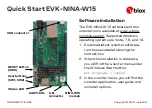
IMPORTANT:
By installing the Sentinel Retro-Link, the MC Plus controller
becomes an FCC Class A device. While sending and receiving radio commands,
the MC Plus will now have a maximum total load of
1.0 A
that may be
programmed to operate simultaneously.
Sentinel Retro-Link provides two-way radio communication capability and
connectivity to the Sentinel Central software for the MC Plus controller. After
installation, all of the pre-programmed irrigation functions, including manual
ON/OFF capabilities, will be disabled. Programming information after installation
of the Retro-Link must be transmitted by the Sentinel central software.
There are two other secondary benefits of installing the Retro-Link. It gives the
MC Plus hand-held radio capability with the use of Sentinel Hand-Held remote,
and it enables flow monitoring of a single flow meter and weather station input
via the sensor input board.
Note:
The Sentinel Central software must be in service and the two-way radio
coverage confirmed prior to Retro-Link installation.
IMPORTANT:
The use of the Sentinel Retro-Link requires a low-power,
narrow-band frequency license. Application and renewal of the frequency license
are the responsibilities of the end-user. Failure to obtain proper frequency
registration and licensure with the FCC subjects the end-user to fines and/or
possible immediate system shutdown at the discretion of the FCC.
Step 1
– Disconnect the main power source to the controller.
Step 2
– Remove the bottom panel of the controller and locate the 1/2"
(19 mm) conduit access hole plug. See
Figure 1
.
Step 3
– Remove the 1/2" (19 mm) access hole plug.
IMPORTANT:
Enclosures with concentric access holes may install the
Retro-Link antenna remotely through the use of conduit or directly to the
enclosure using locking nuts. Otherwise, only install the provided antenna using
the 1/2" (19 mm) conduit knockout.
Step 4
– Install the provided antenna (
Figure 2A
) or the optional Retro-Link
Mast Antenna (
Figure 2B
), service kit 102-3262, to the newly
created access hole.
IMPORTANT:
To avoid damaging the antenna assembly, do not pick up the
antenna by the cable end.
Note:
Sufficiently tighten the lock nut on the antenna to make sure the lock
washer penetrates through the metal cabinet powder coat. It is essential that the
lock washer makes adequate contact with the metal cabinet for proper
grounding.
Step 5
– Use an Ohm meter to verify continuity of the antenna and the metal
cabinet for sufficient ground contact. Probe the antenna lock nut and
the transformer metal base for best results. See
Figure 3
.
IMPORTANT:
The resistance between the antenna lock nut and the
transformer metal base should be less than 2.0 Ohms. With resistance
exceeding 2.0 Ohms, the antenna will not function properly.
Step 6
– Affix the Retro-Link Enable/Disable label in the lower right-hand
corner of the control panel. (Applies to all MC Plus models.)
See
Figure 4
.
IMPORTANT:
It is critical to place the label at the right most corner of the
control panel to avoid damage to electrical components underneath.
Step 7
– Drill a 1/4" (7 mm) diameter hole using a brad-point type drill bit at
the location indicated by
X
on the label. See
Figure 4
insert.
Step 8
– Remove the control panel by unscrewing the two self-retaining
screws to access the back panel of the cabinet. See
Figure 5
.
Step 9
– Thoroughly clean the surface for radio installation. It is
recommended to use alcohol solution. Remove the adhesive
protector from the radio module and radio PCB Velcro. Install the
components as shown in
Figure 6
. Press firmly to adhere properly
in the cabinet.
WARNING: Disconnect Incoming power to the controller prior to servicing. Failure to comply may result in serious
injury due to electrical shock hazard.
Figure 1
Figure 2
Figure 3
A
B
Sentinel Retro-Link for MC Plus Controller
SRL-IR Installation Instructions
Figure 5
Figure 4




















